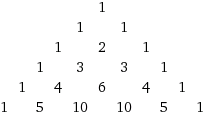Pascal's triangle up to the fifth term is:

You construct this by remembering that the first two rows are all #1#. Then, you add the #1, 1# to get the #2# right below and between the two #1#s from #1, 1#. Basically you add number pairs together and put the result in between and below the number pair. #3 + 3 = 6#, #4 + 6 = 10#, etc.
Starting on the first row, the order is #0#, and as you go down, it increases in integer steps. You can see that the third-order term is therefore #1, 3, 3, 1#. To use it, you have:
#(a + b)^3 = 1a^3b^0 + 3a^2b^1 + 3a^1b^2 + 1a^0b^3#
#(a - b)^3 = 1a^3b^0 - 3a^2b^1 + 3a^1b^2 - 1a^0b^3#
Yours obviously has a subtraction sign; thus, you have, with #a = 2x# and #b = 3y#:
#(2x - 3y)^3#
#= color(blue)(1)(2x)^color(green)(3)(3y)^color(green)(0) - color(blue)(3)(2x)^color(green)(2)(3y)^color(green)(1) + color(blue)(3)(2x)^color(green)(1)(3y)^color(green)(2) - color(blue)(1)(2x)^color(green)(0)(3y)^color(green)(3)#
The triangle coefficients are highlighted in blue. Notice how since it's a cube of a difference, the signs alternate.
Also, notice in green that the order of the first term #(2x)# starts at #3# and ends at #0#, while #(3y)# does the complete opposite, starting at #0# and ending at #3#.
Simplifying it:
#= (2x)^3 - 3(2x)^2(3y) + 3(2x)(3y)^2 - (3y)^3#
#= 8x^3 - (12x^2)(3y) + (6x)(9y^2) - (27y^3)#
#= color(blue)(8x^3 - 36x^2y + 54xy^2 - 27y^3)#

